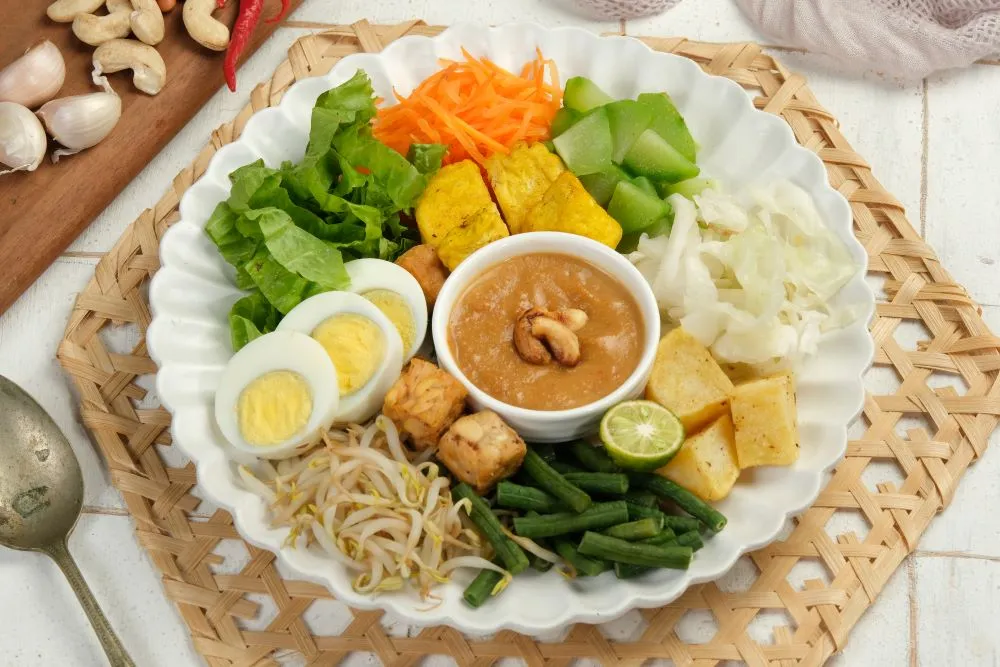Indonesia has a variety of cultural and culinary diversity. One of them is gado-gado, this typical Indonesian salad is popular with various groups. Apart from the basic ingredients being easy to find, it also tastes delicious and healthy. So it is not surprising that the gado-gado business is quite popular among culinary business people.
If you want to try this business, there are several things you need to know. Starting from business excellence to delicious Gado-gado recipes that are definitely addictive. Interested in trying the gado-gado business? Check out the full review here.
The Advantages of the Gado-Gado Business
The gado-gado business has several advantages that can be attractive to culinary business people. This can make the gado-gado business opportunity more promising, see the full review here.
1. Raw Materials that are Easy to Obtain
The ingredients for making gado-gado such as fresh vegetables, tofu, tempeh, lontong and peanut sauce are relatively easy to find in traditional markets and supermarkets at affordable prices.
2. Affordable Business Capital
Starting a gado-gado business does not require large capital. Simple kitchen equipment and a small business premises are enough to start this business.
3. Wide Market Share
Gado-gado is a food that is liked by many people, both young and old. Its distinctive taste and rich vegetables make it popular among healthy food lovers.
4. Easy to Adapt and Varied
Gado-gado can be adjusted to suit consumer tastes, for example by adding additional ingredients such as eggs, chicken or crackers. This provides flexibility in the menu and can attract more customers.
5. High Nutritional Value
Gado-gado contains various kinds of vegetables which are rich in vitamins and fiber. There is also protein from tofu and tempeh, this makes gado-gado a healthy choice for daily consumption.
6. Suitable for Various Occasions
Gado-gado can be served as a main meal, snack or appetizer. This flexibility makes it suitable for a variety of events and occasions.
7. Relatively Easy Processing
The process of making gado-gado does not require complicated cooking techniques, so it is relatively easy for anyone to learn and carry out.
Risks of Gado Gado Businesses
Even though the gado-gado business has many advantages, there are also several risks that need to be paid attention to by those involved in this business. The following are some risks that may be faced in a gado-gado business:
1. Raw Material Durability
Fresh vegetables, tofu and tempeh, which are the main ingredients for gado-gado, have a limited shelf life and quickly spoil if not stored properly. This can lead to losses if raw materials are not sold or used on time.
2. Tight Competition
Gado-gado is a very popular traditional Indonesian food, so many sellers offer similar products. High competition can make it difficult for this business to attract the attention of new customers, especially if there is no added value or difference in the products offered.
3. Dependence on Weather
The gado-gado business can be influenced by weather conditions. During the rainy season, consumers' interest in buying foods containing raw or fresh vegetables may decrease, as more people tend to look for warm foods.
4. Fluctuations in Raw Material Prices
Prices of vegetables and other raw materials can fluctuate, especially during certain seasons or if there are distribution problems. This increase in raw material prices can affect profit margins.
5. Cleanliness Management
Quality and cleanliness are very important in the food business. If cleanliness is not maintained, this business risks losing customer trust, and may even face health or legal problems if a case of food poisoning occurs.
6. Changes in Consumer Tastes
Consumer tastes and preferences may change over time. Even though gado-gado is a popular traditional food, it is possible that consumers may switch to other types of food that are considered more trendy or healthy.
7. Dependence on Location
Business location greatly influences the number of customers. If the location is less strategic or not crowded with visitors, sales may decline. This also applies if the business is in an area where competition is very high.
8. Limited Production Capacity
If the business grows rapidly and demand increases, the ability to meet that demand can become a challenge. Limited production capacity or labor can be an obstacle in maintaining quality and service.
Tips for Starting a Gado Gado Business
Starting a gado-gado business can be a profitable opportunity if managed well. Here are some tips for starting a gado-gado business.
1. Market and Location Research
Carry out market research first to find out the needs and tastes of consumers in the targeted area. Choose a busy strategic location, such as near offices, schools, markets or residential areas. A location that is easy to reach and has a lot of foot traffic can increase your chances of getting customers.
2. Quality of Raw Materials
Make sure to always use fresh and quality raw materials. Fresh vegetables, tofu, tempeh, and delicious peanut sauce will greatly influence the taste of gado-gado. Collaborate with trusted local suppliers to ensure the supply of raw materials is maintained.
3. Menu Creativity
Even though gado-gado is a traditional food, don't hesitate to innovate by adding variations to the menu. For example, offering gado-gado with additional toppings such as shredded chicken, shrimp, quail eggs or special crackers. Variants of peanut sauce with different levels of spiciness can also attract customers' attention.
4. Interesting Presentation
An attractive way of serving can increase the attractiveness of food. Use attractive and aesthetic serving containers, and arrange vegetables neatly. This not only adds aesthetic value but also gives a hygienic and professional impression.
5. Effective Promotion
Use social media to promote your gado-gado business. Create an account on a platform like Instagram, Facebook, or TikTok to post food photos and offer special promotions. Additionally, take advantage of delivery services or online food platforms to reach more customers.
6. Good Service
Friendly and fast service will increase customer satisfaction. Provide training to employees on the importance of providing good service, maintaining cleanliness, and interacting politely with customers.
7. Offer Competitive Prices
Determine the price according to the quality and portions offered. Make sure the price set is competitive and in line with the target market you want to achieve. Don't forget to take into account operational costs and the desired profit margin.
8. Pay Attention to Business Licensing
Make sure to take care of the permits needed to run a food business, such as business permits, permits from the health department, and halal certification (if required). Having official permission will add credibility and customer trust.
9. Feedback from Customers
Apart from maintaining taste quality, feedback from customers is also important to convince other consumers. Provide a suggestion box or use social media to interact with customers, accommodate criticism and suggestions.
10. Always Pay Attention to Cleanliness
Ensure that the business premises and equipment are always in a clean and hygienic condition. Cleanliness is an important factor in culinary businesses to maintain the health and trust of customers.
Estimated Capital for a Gado Gado Business
Before starting a business, of course you need to know what you have to prepare. Starting from capital to calculating profits, it is necessary to carry out an analysis of the Gado gado business so that it runs smoothly in the future. Check out the full review here.
Assumptions:
The cart's usage period is 4 years
The usage period for cooking equipment, chairs and tables is 3 years
The use period for cutlery, mortar and pestle is 2 years
Investment Costs
Cart: Rp. 3,500,000
Tableware: Rp. 350,000
Cooking equipment: Rp. 800,000
Tear and pestle: Rp. 150,000
Table and chairs: Rp. 500,000
TOTAL IDR 5,300,000
Operational Costs per Month
Cart depreciation: 1/48 x Rp. 3,500,000 = Rp. 73,000
Depreciation on tableware: 1/24 x Rp. 350,000 = Rp. 15,000
Depreciation of cooking equipment: 1/36 x Rp. 800,000 = Rp. 23,000
Mortar and pestle shrinkage: 1/24 x Rp. 150,000 = Rp. 7,000
Depreciation of tables and chairs: 1/36 x Rp. 500,000 = Rp. 14,000
TOTAL Rp. 132,000
Variable Costs
Vegetables, tempeh and tofu: IDR 200,000/day x 30 days = IDR 6,000,000
Peanuts: 6 kg x IDR 15,000/kg x 30 days = IDR 2,700,000
Condiments (chilies, brown sugar, shrimp paste): IDR 35,000/day x 30 days = IDR 1,050,000
Lontong: IDR 70,000 x 30 days = IDR 2,100,000
Package container: 15,000/day x 30 days = Rp. 450,000
Mineral water: IDR 28,000/week x 4 weeks = IDR 112,000
3 kg LPG gas: IDR 20,000/canister x 15 uses = IDR 300,000
Transportation: IDR 15,000/day x 30 days = IDR 450,000
TOTAL IDR 13,162,000
Income per Month
Gado-gado price: IDR 8,000/portion
Sales: 70 portions x IDR 8,000 x 30 days = IDR 16,800,000
Profit per Month
Total revenue - total operating costs
= IDR 16,800,000 - (IDR 132,000 + IDR 13,162,000)
= IDR 16,800,000 - IDR 13,294,000
= IDR 3,506,000
Simple Gado-Gado Recipe
Here is a simple recipe for making gado-gado, a traditional Indonesian food that is healthy and delicious.
Gado Gado Ingredients
Vegetables (all boiled or lightly steamed)
- 100 grams long beans, cut into 4 cm lengths
- 100 grams of bean sprouts, weed the ends
- 100 grams cabbage, thinly sliced
- 1 potato, cut into cubes
- 1 carrot, cut into matchstick size
- 1 cucumber, thinly sliced
- 4 lettuce leaves
Complementary
- 2 pieces of tofu, fried and cut into cubes
- 2 tempeh, fried and cut into cubes
- 2 boiled eggs, cut in half
- Lontong or rice, according to taste
- Crackers (shrimp crackers or emping crackers)
Peanut Sauce Ingredients
- 200 grams of peanuts, fried and pureed
- 3 cloves of garlic
- 3 large red chilies (adjust the level of spiciness)
- 2 kaffir lime leaves
- 2 tablespoons brown sugar, finely shaved
- 2 tablespoons tamarind water
- 300 ml boiled water
- 1 tsp salt
- 2 tablespoons sweet soy sauce
- 1 tablespoon cooking oil (for frying)
How to Make Gado-Gado
Vegetable Preparation
- Boil or steam long beans, bean sprouts, cabbage, potatoes and carrots separately until half cooked. Lift and drain
- Prepare cucumber and fresh lettuce leaves as a complement
Make Peanut Sauce
- Puree the garlic and red chilies
- Heat cooking oil in a frying pan, saute ground spices until fragrant
- Add the ground peanuts, stir well
- Add kaffir lime leaves, brown sugar, salt and tamarind juice. Stir until evenly mixed
- Pour in the water little by little while continuing to stir until the sauce reaches the desired consistency
- Add sweet soy sauce and stir again. Cook until it boils and thickens, remove from heat and set aside
Presentation
- Arrange the vegetables, tofu, tempeh, and boiled eggs on a serving plate
- Drizzle with the peanut sauce that has been made
- Add crackers on the side
- Serve with lontong or rice according to taste
That's a review of success tips and analysis of the gado-gado business. The information above can be your guide before getting involved in this culinary business. Especially for those who are just starting a gado-gado business, of course there is a lot that must be prepared so that the results obtained are maximum. Good luck!
---
If you are interested in running a gado gado business and need additional business capital, you can apply for business capital financing through BFI Finance! BFI Finance is the first and most trusted financing company in Indonesia that provides financing with vehicle collateral and house certificates. Enjoy high disbursement of funds and fast approval process. #SelaluAdaJalan with BFI Finance.






